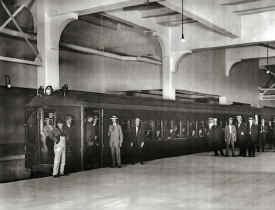|
LIRR - First Train from Penn Station |
||
|---|---|---|
|
Keystone Aspirations: "The Evolution, Creation and Construction of Pennsylvania Station" Special Issue Number 1, by George Chiasson, Jr. offered to members of the New England Chapter, Pennsylvania Railroad Technical & Historical Society This is a very basic but detailed history describing the conception, planning, construction, architecture, scope and operations of New York City’s famed Pennsylvania Station, from its beginnings as a mere idea in 1897 through the time of its initial opening for trains of the Long Island Rail Road in September 1910. Included in the 74-page Special Issue are 5 railway maps and diagrams of Greater New York, interior plans of Penn Station at its opening and three timetables depicting the railway facilities of that era in an ETT format. Obtainable in electronic form (.pdf) through annual membership in: The New England Chapter, Pennsylvania Railroad Technical & Historical Society PO Box 624, Marlborough, Massachusetts 01752-0624 2015 Dues are $15, and includes subscription to the chapter’s regular quarterly electronic (.PDF) publication: “The East Wind,” plus additional Special Editions as they are published. Read PART
5: PENN STATION OPENS AND A SUBURBAN COLOSSUS EMERGES by George
Chiasson, Jr. |
||
|
THE LONG ISLAND
HISTORICAL JOURNAL - Fall 2004/Spring 2005 Volume 17, Nos. 1-2 |
||
|
As the LIRR system’s shape matured in the late nineteenth century, the railroad could no longer count on expansion to increase
ridership. To increase traffic, the LIRR began a new promotional campaign: commutation. It published “booklets setting forth the advantages of every little town.” The railroad recognized that commutation had enormous revenue potential. If it could convince a critical mass of people to become suburban commuters, the LIRR would see a sizeable increase in the number of daily riders. Thus, beginning in the 1870s, the LIRR Passenger Department tried to convince potential Long Island homeowners that daily commutation to New York City was manageable. |
||
|
|
||
|
Brooklyn was the first major commuter terminal, not Long Island City. We forget that Brooklyn was itself a major destination with a large LI-oriented business and legal community. Downtown Manhattan passengers transferred to Brooklyn Bridge trains or the Fulton Ferry (and later the subway) to get to Manhattan as well – cheaper, faster and more convenient than going to NYP and doubling back downtown. Of course the cheaper went away when the MTA made Flatbush Avenue the same fare zone as NYP, and more riders drifted to NYP because of better service and the steady decimation of Brooklyn trains as a result. I’ve seen figures in Regional Plan publications that indicate the majority of commuters – people using weekly or monthly tickets – used Flatbush Avenue until shortly after WW II. One ways, ten trips etc. were the vast majority at LI City, and later Penn Station. As a side note – the majority of PRR riders using commutation tickets continued to use Exchange Place until shortly after WW II as well. Jim Guthrie |
||
|
1st LIRR train filled with special invitees (press, dignitaries, officials) about to leave the newly-opened Pennsylvania Station for points east on Long Island on September 8, 1910. Once on Long Island, passengers on the electric MU train changed to steam-drawn trains for non-electrified branches and probably to other MU trains for the other electrified branches, passing bunting-bedecked depot buildings and assembled crowds along the way. Info: Dave Keller
|
||
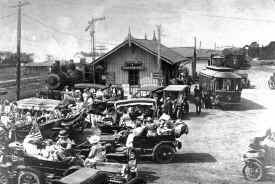 H3 2-8-0 #162 Pulling 1st Train from Penn Station at Northport Northport Traction #601 9/08/1910 Archive: Dave Keller |
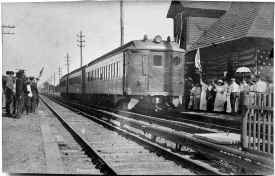 MU first from Penn Station at East Rockaway 9/08/1910 |
|
|
|
|
|
| First Train from Penn Station at Lynbrook 09/08/1910 Archive: Art Huneke | ||
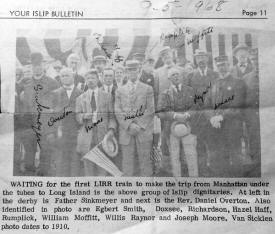 First train from Penn Station - Islip dignitaries 9/08/1910 Islip Bulletin Archive: Jeff Fisher |
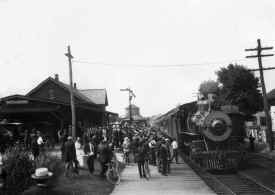 First train from Penn Station at Patchogue 9/08/1910 Archive: Dave Keller |
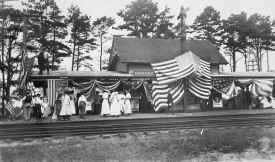 Awaiting arrival of first train from Penn at Brookhaven 9/08/1910 Photo: Post-Morrow Foundation Historical Collection |
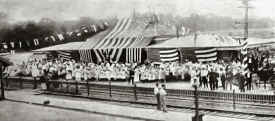 Awaiting arrival of first train from Penn at Islip 9/08/1910 Archive: Islip Historical Society |
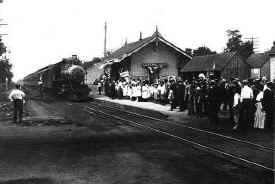 LIRR D16b (4-4-0) #201 first train from Penn Station at Central Islip 9/08/1910 (George G. Ayling collection, Dave Keller archive) |
|
| The trains left Penn Station as MU electrics and switched to steam power at "H" tower in Sunnyside or at Jamaica. Info: Dave Keller | ||
| First MU Electric Train from Penn Station to Babylon | ||
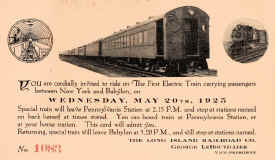 LIRR 1st MU electric train to Babylon Pass 5/20/1925 Archive: Brad Phillips 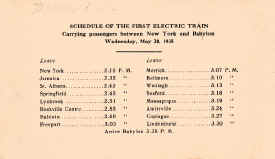 |
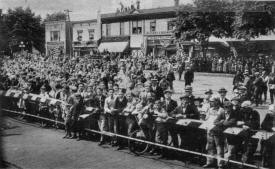 Rockville Centre, South Station Plaza First electric train 5/20/1925 Archive: Dave Morrison
|
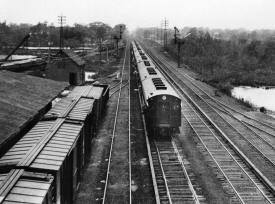 First electric MP54C's and trailers train - Babylon 5/20/1925 (Osborne-Boland)
|
| Rockaway Jct. to Babylon via “Springfield Branch,” in service: 5/21/1925 Info: Robert Emery | ||
